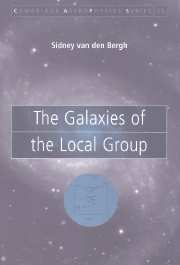Book contents
- Frontmatter
- Contents
- Preface
- 1 Introduction
- 2 Local Group membership
- 3 The Andromeda galaxy (M31)
- 4 The Milky Way system
- 5 The Triangulum galaxy (M33)
- 6 The Large Magellanic Cloud
- 7 The Small Magellanic Cloud
- 8 The elliptical galaxy M32 (= NGC 221)
- 9 The irregular dwarf galaxy NGC 6822
- 10 The starburst galaxy IC 10
- 11 Faint dwarf irregular galaxies
- 12 Spheroidal galaxies
- 13 The most luminous dwarf spheroidal galaxies
- 14 Dwarf spheroidals in the Andromeda subgroup
- 15 Faint dwarf spheroidals
- 16 The outer fringes of the Local Group
- 17 Intergalactic matter in the Local Group
- 18 Dynamical and physical evolution
- 19 Properties of the Local Group
- 20 Conclusions
- Glossary
- Bibliography
- Object Index
14 - Dwarf spheroidals in the Andromeda subgroup
Published online by Cambridge University Press: 22 August 2009
- Frontmatter
- Contents
- Preface
- 1 Introduction
- 2 Local Group membership
- 3 The Andromeda galaxy (M31)
- 4 The Milky Way system
- 5 The Triangulum galaxy (M33)
- 6 The Large Magellanic Cloud
- 7 The Small Magellanic Cloud
- 8 The elliptical galaxy M32 (= NGC 221)
- 9 The irregular dwarf galaxy NGC 6822
- 10 The starburst galaxy IC 10
- 11 Faint dwarf irregular galaxies
- 12 Spheroidal galaxies
- 13 The most luminous dwarf spheroidal galaxies
- 14 Dwarf spheroidals in the Andromeda subgroup
- 15 Faint dwarf spheroidals
- 16 The outer fringes of the Local Group
- 17 Intergalactic matter in the Local Group
- 18 Dynamical and physical evolution
- 19 Properties of the Local Group
- 20 Conclusions
- Glossary
- Bibliography
- Object Index
Summary
Introduction
While inspecting a mosaic of nine deep IIIaJ plates of M31 and its environment taken with the Palomar 1.2-m Schmidt telescope, van den Bergh (1972a) discovered three faint nebulous patches that were immediately suspected of being dwarf spheroidal companions to the Andromeda galaxy. These objects were dubbed Andromeda I, Andromeda II, and Andromeda III. Subsequently van den Bergh (1972b) used the Palomar 5-m Hale reflector to resolve And III into stars that had approximately the same V magnitude as the brightest stars in NGC 185 and NGC 205. Later van den Bergh (1974b) showed that And I and And II resolve at about the same magnitude as And III. These observations indicated that And I, And II, and And III are all located at about the same distance as M31. The suspicion that they are physically associated with M31 was strengthened by a Palomar Schmidt survey of an area of ∼700 square degrees surrounding the Andromeda galaxy, which showed that And I, II, and III are concentrated toward M31. Of a fourth candidate van den Bergh (1972a) wrote: “The object And IV is probably not a dwarf spheroidal galaxy. It is smaller and bluer than the other objects in Table 1 [i.e., And I, II & III]. Furthermore, And IV has a much higher surface brightness than do the other galaxies in this table. This suggests that And IV, which is located very close to M31, might be a relatively old star cloud in the outer Disk of M31.”
Information
- Type
- Chapter
- Information
- The Galaxies of the Local Group , pp. 234 - 242Publisher: Cambridge University PressPrint publication year: 2000
